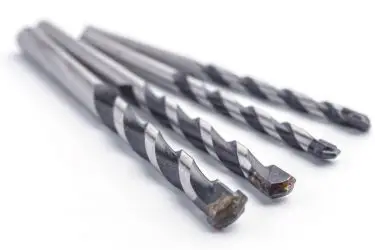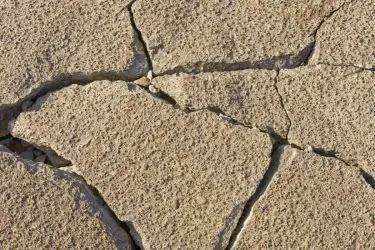“Step on a crack, break your mother’s back” is a famous children’s superstition recited by kids as they skip down fractured sidewalks. Although cracks can’t actually harm your loved ones, they can harm the concrete that you are stepping on. Cracks plague a majority of the concrete that we walk, park, drive, and build on, and even what we live and work in.
Concrete cracks based on the temperature of the environment in which it is poured, the mixture of the concrete, the ground on which it is poured, and chemical reactions that can happen inside or on top of the concrete. Some cracks can be merely cosmetic while others can be structurally damaging.
All concrete cracks. This is a fact that no one likes to hear. Cracking can start taking place within 12 hours of it being poured, but the actual timeline of it can depend on the temperature or the weather outside.
Cracking tends to happen within the first 30 days of a concrete structure’s life, so make sure to have a watchful eye during that time to ensure that the concrete isn’t cracking due to any structural issues.

Table of Contents
Main Causes Of Concrete Cracking
Concrete Cracks When Shrinking
It’s not just your clothes that can shrink, but concrete too. Shrinking is one of the most common ways that concrete cracks.
To understand how concrete shrinks, one needs to understand how concrete is made.
Concrete is made up of a paste and an aggregate. The paste is usually created by mixing a powder cement, like the typical Portland cement, and water together to get an even texture. The aggregate usually used to give the concrete substance and more strength are materials like sand and gravel.
To make concrete, it is essential to get the correct consistency of the concrete before pouring it into the desired site. This consistency is largely based on how much water is in the mixture to the number of dry ingredients.
The ratio of water to dry ingredients always depends on the kind of concrete being used. For example, if you are using Quikrete, the ratio of water to Quikrete powder is 3 quarts of water to every 80 pounds of powder mix (which is usually a whole bag).
The ideal consistency of a concrete mixture is something similar to oatmeal or peanut butter; smooth and thick. If a concrete mixture isn’t similar to this texture, add either more water or more cement powder to make it either wetter or drier.
Be aware that the more water you add to a concrete mixture, the less strength it will have. If the concrete is too wet it can cause cracks.
It’s important to remember that when mixing the dry ingredients with water, it is essential to only pour 2/3 of the water in first to mix with the dry materials and then to pour in the remaining 1/3 after everything is mixed up. If this is not observed, it can have a great effect on the consistency of the concrete and cause shrinking later on.
After pouring the newly made concrete mix into the desired area, it starts to dry and harden, which also makes it shrink.
As the concrete is drying, the water inside of the mixture evaporates, and the concrete mixture shrinks.
This shrinking causes stress and immense pressure inside the very strong and solid concrete structure. This pressure is only received by the concrete cracking.
The amount of cracks caused by this shrinking/drying process is entirely dependent on the consistency of and the amount of water in the mix.
The more water in the mix, the more cracks there are in a piece of concrete. These cracks that appear are not just in the surface of the concrete, but extend into the piece of concrete and weaken the structural integrity of the concrete.
Expansion Caused by Heat Can Make Concrete Crack
The weather has a big impact on whether or not concrete cracks. Heat can cause a concrete slab or structure to crack.
Heat causes a lot of materials and items to swell and expand when exposed long enough, and this also applies to concrete.
This expansion caused by heat puts stress on the concrete and it seeks to receive it. If the concrete isn’t given proper room to flex and expand (ex. having another piece of concrete or another hard surface like a brick next to it), it will crack to relieve the pressure.
Read more: Why Does Concrete Buckle from Heat? (And how to prevent it)
The Freeze-Thaw Cycle Can Make Concrete Move
Just like how cracks are caused by hot temperatures, cold temperatures can also cause cracking in our knuckles and in the concrete around us.
When it is cold, the frozen earth can lift a couple of inches from its normal position and then go back to normal when it thaws out. This process is called the freeze-thaw cycle and takes place practically every year in cold regions of the world.
Related article: Pouring Concrete in the Cold: How to ensure it won’t crack
While most people don’t notice or feel this process taking place, concrete does.
If the slab of concrete isn’t free to move with the ground around it that is lifting, the concrete will crack to move.
This causes a jagged uneven surface in the structure that is mostly seen in sidewalks.
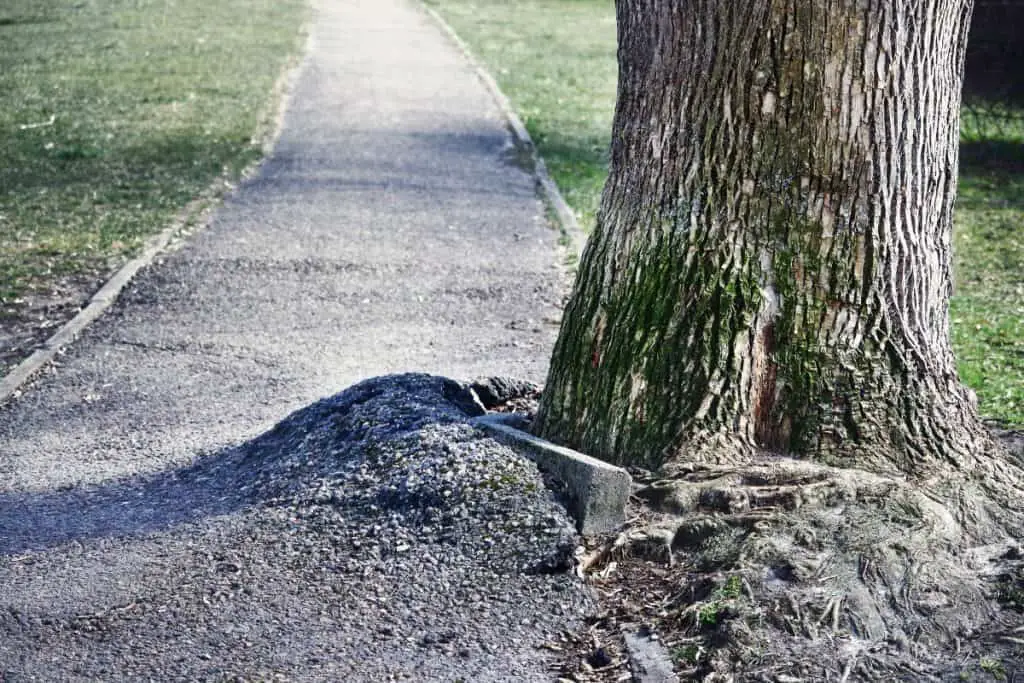
Another cause of heaving can be thick plant roots, like trees that grow too close to the concrete slab or structure. As these roots grow and expand to accommodate the plant, they can go under concrete slabs and upheave them.
Ground Settling Can Make Concrete Crack
As humans, we are very industrious people. We are always expanding. When there isn’t enough space on top of the earth to put things, we put them below the earth.
When building a house and even a city, we place important pipes like gas, water, and plumbing, and sometimes even electricity lines, underneath the surface of the ground. Trenches are dug for these important utilities so they can lay in the ground correctly.
Related article: Why Does Concrete Get Pitted?
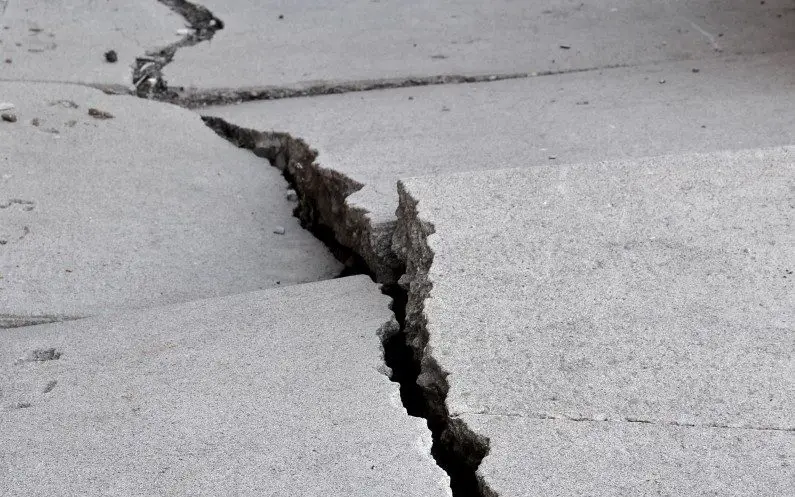
In a lot of cases, these trenches aren’t compacted correctly and the ground will shift over time to settle in its correct place.
This settling, usually a form of subsidence, causes the concrete that is placed on top of all this to crack due to the lack of support and structure beneath it.
Too Much Pressure Will Make Concrete Crack
Concrete is known to be a very strong material capable of supporting a large amount of weight. But concrete doesn’t have super strength and does have a limit on how much weight it can support before cracking. That is why reinforcement is used in concrete projects.
Every kind of concrete has a certain PSI, or pounds per square inch, that it is able to bear. That means that it would take a certain amount of weight to create enough pressure to crush it.
For example, modern concrete, the most common type of concrete, can withstand up to 4,000 PSI before it is expected to crack. High-strength concrete is modified so it can support anything over 6,000 PSI.
The strongest type of concrete is called ultra-high performance concrete and it is made to withstand up to 29,000 PSI.
When concrete is put in a situation where it is supposed to bear an excessive weight, it will crack.
Another way that concrete can crack under these kinds of circumstances is when the ground underneath the concrete can’t support the weight placed on the concrete and sinks, causing the concrete to crack due to the lack of flexibility.
The ground underneath the concrete usually is affected by rainfall or excessive water exposure to make it soft and weak so that it can’t support much.
Uneven Drying Causes Fine-Lined Cracks
Premature cracks, also called craze cracks, are fine-lined cracks that appear on the surface of the concrete. These cracks are caused by an uneven drying process that takes place in the concrete.
Sometimes the top of the concrete can dry faster than the rest of the concrete due to heat, wind, or other conditions that make it lose moisture faster.
The top of the concrete will shrink before the rest of it and it will cause tiny cracks across the whole surface of the concrete.
These cracks do not affect structural integrity like most cracks do, but are only cosmetic. Sadly there is no way to repair this kind of crack because of how small they are, they will just be there to frustrate a person for years to come. Or you might consider resurfacing your concrete.
Another kind of cracking that is caused by premature drying is crusting cracks that usually take place while stamping concrete.
Stamping concrete is a process that takes place after a layer of concrete is poured. A mold, or stamp, is applied to the surface of the concrete to give it a more attractive and different finish.
Depending on the different weather conditions listed above, the top of the concrete can become very dry and almost crust on top. When pressing the stamp down into the concrete, the surface of the concrete is pulled apart near the stamped joint and this can create small minor cracks in the surface.
Cracks Can Appear When Concrete Is Drying Too Fast
Similar to what takes place to cause craze cracks, chemical reactions in the concrete itself can cause rapid drying which can form cracks in the internal structure of the concrete.
One type of concrete that is subject to this issue is high-strength concrete. Due to the use of silica fume in the concrete mixture, the drying time is sped up in the mixture.
This can make the concrete dry too fast and cause cracks in the surface of the concrete and also in the internal structure.
To prevent this cracking, a superplasticizer will need to be added to the mixture to slow down the chemical reaction that makes the concrete dry.
Chemicals Like De-Icing Salt Can Make Concrete Crack
Chemicals are the unsuspecting killers of concrete. Over a long amount of time, chemicals eat away at the concrete until its integrity is destroyed.
One chemical that most people don’t know actually produces cracks in concrete is salt. In the cold winter months, people use salt on their driveways, sidewalks, and patios to encourage the ice and snow to melt, providing safer places to walk.
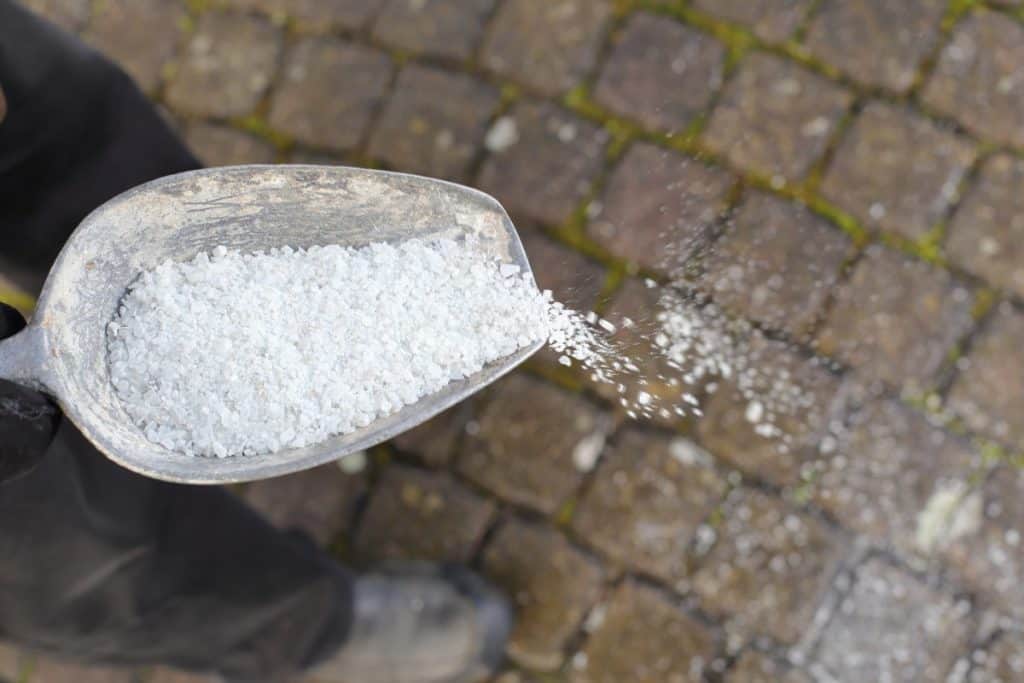
Even though salt is super effective as a melter, it is very effective in destroying the concrete that it is placed on.
Salt can attract moisture in the concrete and create more pressure in the frozen water, and even increase the amount of freeze-thaw cycles that take place inside of a piece of concrete.
Moisture in concrete, especially in cold temperatures when you would use salt, can cause the concrete to expand by 9 percent.
This expansion causes tremendous stress on the concrete each time the moisture in the concrete freezes. After a couple of freeze-thaw cycles, the concrete may have multiple cracks in it due to the buildup of pressure.
It would be better to never use salt on concrete, but it is one of the most effective substances to melt ice. It is recommended to not put any salt on concrete for the first couple of years so it can retain its strength.
As a good substitute for salt, sand can be used on concrete without affecting the surface.
Another chemical issue that can occur in concrete is if the actual concrete isn’t chemically reacting well. The aggregates and cements might not be combing well and could reject each other, causing structural damage in the concrete in the form of major cracks.
Corrosion
Concrete is a porous material and is prone to water getting into the structure and causing all sorts of problems.
Most concrete structures are made with reinforcement to strengthen the integrity of the concrete.
When making a concrete slab, metal rebars or steel wire mesh is placed down in a grid pattern in the wanted area where the concrete will be poured. Then, concrete is poured on top of it to complete the project.
This kind of reinforcement is used when making sidewalks, driveways, and even parking garages.
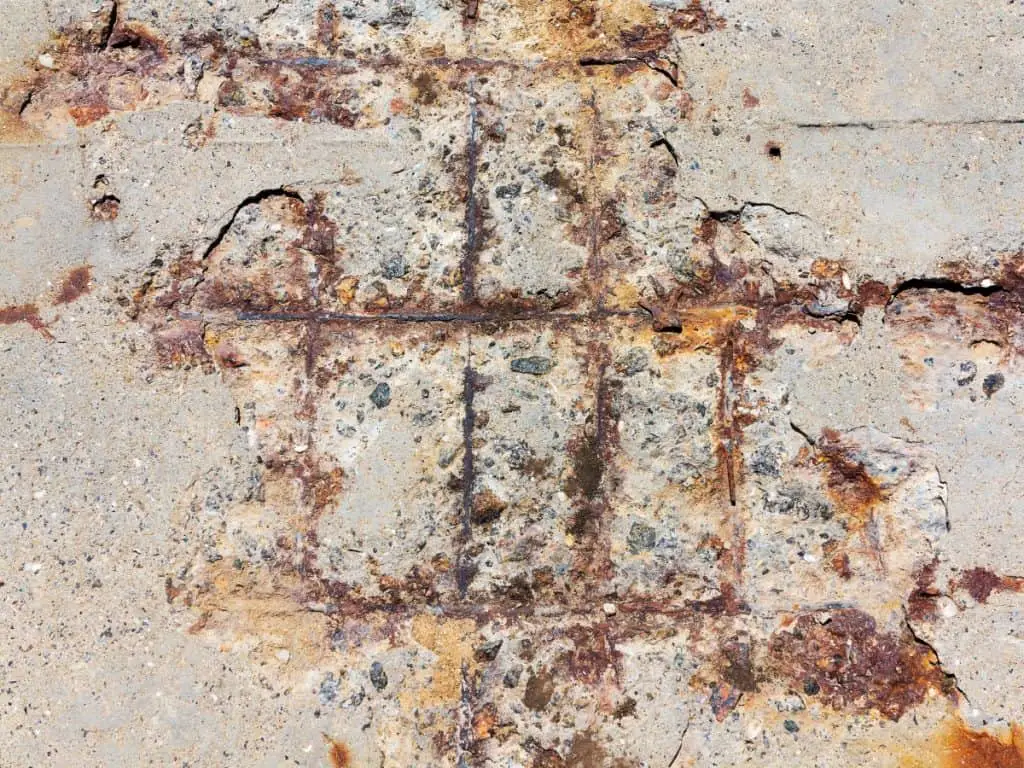
When water or moisture of some sort gets into the small crevices of poured concrete, it can affect the metal reinforcement.
When wire or steel mesh makes contact with water and oxygen, the metal starts to corrode due to a process called rusting.
Rust is an expansive chemical reaction and causes the metal to push the concrete around it, causing cracks and destroying the concrete structure as a whole.

